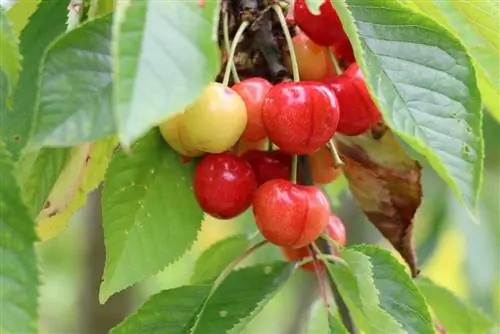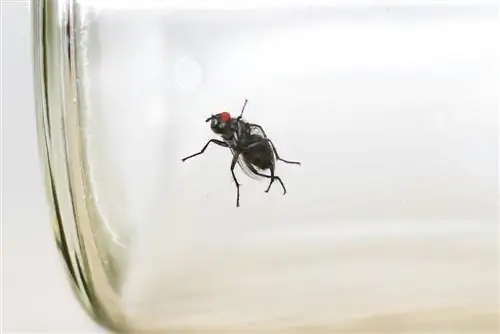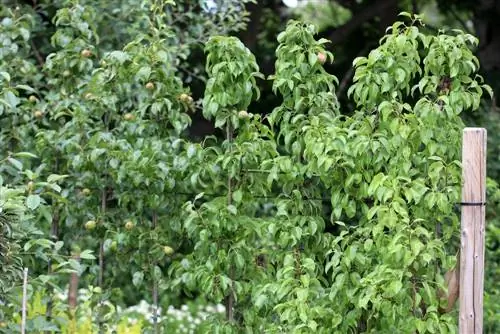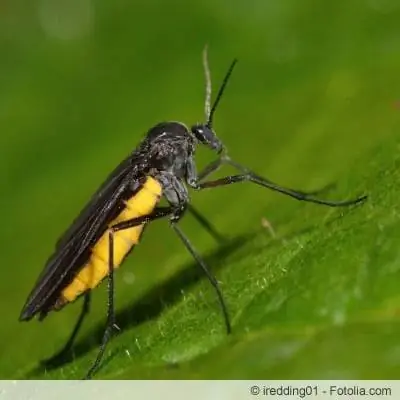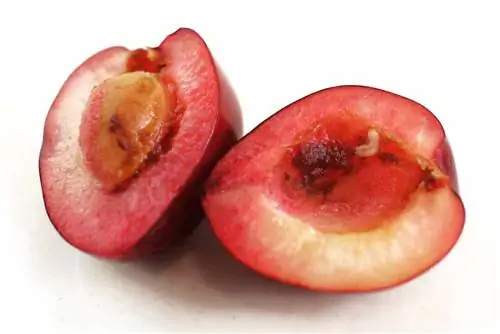- Author admin [email protected].
- Public 2023-12-17 03:39.
- Last modified 2025-01-24 12:45.
An infestation of local cherry trees with cherry fruit flies can develop into a real plague and make the cherry harvest completely inedible. In order to protect the delicious fruits from the voracious maggots of flies, in most cases a mixture of different defense methods is necessary. These countermeasures concern both spraying agents as well as precaution and the selection of a more resistant variety.
General information
The cherry fruit fly is a feared pest that reproduces with the help of cherries. At the end of spring, the fly specifically visits cherry trees to feed on the fruit and lay its eggs there. Especially when the sun is shining, the cherry fruit flies suck out the food and host plants in order to prepare for reproduction. The larvae that then hatch often eat their way all the way to the cherry stone and destroy the entire fruit. After the eggs are laid and the larvae are formed, the cherries begin to rot and then fall to the ground. Late-ripening varieties are particularly affected because the flies only start breeding at the beginning of summer. This pest can develop into an extreme nuisance, especially in very dry years with warm temperatures and little rainfall.
- Preferably sour cherries, snowberries, bird cherries and bird cherries
- Cherry fruit fly grows between 3.5-5 mm
- Emerges from the pupae in the ground in spring
- Flight time is between mid-May to early July
- Feeds on the nectar of cherries for about 10 days
- Up to 200 eggs are then laid
- Lay eggs only in yellow to light red fruits
- The maggots hatch after 5-12 days
- The fruits leave after approx. 3-4 weeks
Symptoms
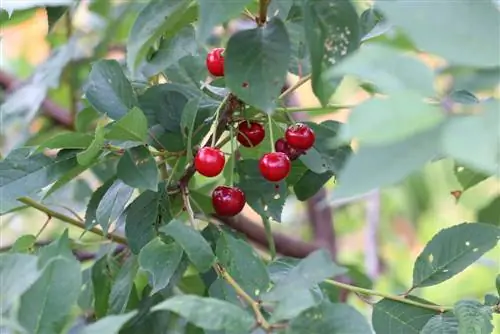
The cherry fruit fly has the botanical name Rhagoletis cerasi and is widespread in both Europe and Asia. It has certain similarities to the common housefly, but if you look closely you can quickly spot the differences. Due to its distinctive appearance, the pest can be easily recognized in the garden. If the flies are present in large numbers, then they are either on the way or an infestation has already occurred. Infected fruits only change after some time, so the cherry trees should always be monitored and the fruits should be checked regularly for changes. This is the only way to take appropriate countermeasures in a timely manner to prevent the spread of a plague and save the rest of the harvest.
- Fly is characterized by wings with brownish bands in a transverse shape
- Green compound eyes are characteristic
- Forms trapezoidal and yellow dorsal shield, which is extremely conspicuous
- Infestation is evident in the stem area through brownish discolored areas
- The pulp becomes soft around the core and begins to rot
- There are one or more maggots inside the fruit
- Maggots are white and grow up to 6 mm long
- Mostly stay near the core
- When the fruit is torn open, maggots are clearly visible
- Flies can lay up to 80 eggs in a single fruit
- Single fly can infest more than one kilogram of cherries
Chemical sprays
Most chemical agents against the cherry fruit fly are no longer permitted in Germany. However, there are still a few remedies that are not permitted in home gardens.
- Mospilan SG can only be used for professional fruit cultivation
- May only be used by qualified persons
- Chemical agent is not approved for home and allotment use
Biological sprays
For private use, there are biological sprays against the cherry fruit fly that can be purchased from specialist retailers and online. The main opponents of the cherry fruit fly are fungi, which attack the insects and thereby render them harmless. These are biodegradable and harmless to humans. However, the fungal spores are inactivated relatively quickly by the UV rays, so the treatment must be carried out several times. In this way, flies that hatch later are also destroyed.
- Use fungal-based plant protection products
- The mushroom Beauveria bassiana has proven itself
- Repeated treatments are necessary to achieve high levels of effectiveness
- Carry out the first treatment about a week after the start of the flight
- It is important that sufficient application is made on well-cut trees
- Complete wetting of the entire tree crown is required
- Repeat every week until a few days before harvest
Yellow boards
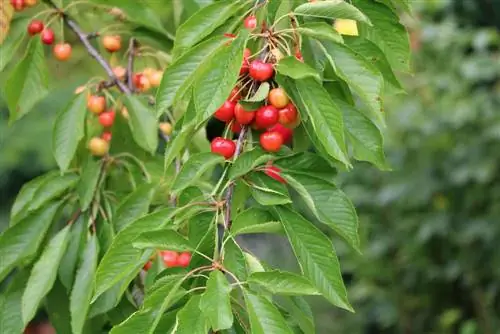
At the time of laying, the cherry fruits are still yellow and are just ripening, which is why the cherry fruit flies are fixated on their yellow coloring. Yellow panels are a biological control measure against the cherry fruit fly and are suitable for trapping the pests. These attract the flies when the fruit begins to turn yellow and keep them away from the cherries. However, the yellow glue boards must be installed in sufficient quantities at the start of the flight, otherwise an infestation may have already occurred. Since a single fly can lay up to 200 eggs, this method is very useful for protecting the cherries. However, the panels should only be used from the start of flight until the end of the harvest, as they also attract other and often useful insects and cause them to die.
- Attach 2-10 panels depending on the tree size
- Use at least two traps per meter of tree height
- Attach to the south and west sides of the tree
- Ideally install on the outside of the crown
- Flies are attracted by the yellow color
- Stay stuck to the glued surface
- Method catches a large proportion of flies
- Egg laying is sustainably prevented in this way
Tip:
If you want to increase the effect of the yellow panels, you can add an attractant to the traps. These pheromone traps are also available ready-made to buy from specialist retailers.
Network coverage
A holistic measure against an infestation with cherry fruit flies is to protect the fruit with the help of a net. However, this method is somewhat difficult with old trees. If the trees exceed the height of a house and have extremely sprawling branches, then it is a difficult undertaking to cover and protect the entire tree crown with a net. When buying the nets, it is important to pay attention to the correct dimensions of the mesh. If the holes in the net are too large, the cherry fruit flies can easily slip through the mesh and still lay their eggs in the cherries. In addition, the nets also provide good protection against other pests and voracious birds.
Tip:
Nets are ideal for smaller trees.
- Also useful for sections of the cherry tree
- For very large trees, only protect areas with lots of fruit
- Tight-meshed nets are available at hardware stores and garden centers
- Stitches must not be too wide
- Mesh thickness should be between 0.8-1.2 mm
Ground Cover
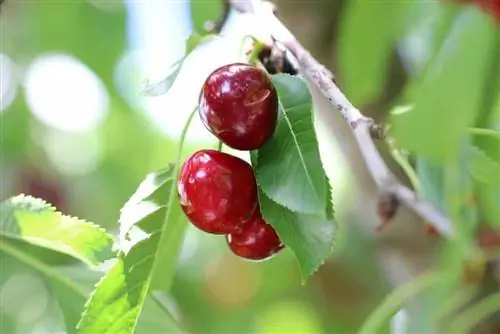
The cherry fruit flies emerge from the pupae from mid-May, which have overwintered in the soil at a depth of approx. 3 cm. This time depends on the weather and can therefore vary from year to year. If the ground is covered, the emergence of adult flies from the ground can be temporarily suppressed. Furthermore, a ground cover can prevent the maggots from burrowing into the ground right from the start. The maggots either fall to the ground from the eaten cherries or fall down from the tree along with the rotten cherries. The maggots then crawl into the ground. If this contact with soil is broken, no new cherry fruit flies will hatch at the end of the next spring.
- Cover the ground with nets before hatching
- Dig the edges of the net deeper to ensure a firm hold
- Flies remain trapped under the net until harvest
- Needed mesh size 0.8-1.2 mm
- Lay out tarpaulin or fleece on the ground under the cherry tree
- All falling cherries and maggots land on a laid surface
- Afterwards, sweep up and collect everything that has fallen down every day
- Put maggots and fallen fruit in transparent, tightly sealable garbage bags
- Leave the bag in the blazing sun
- All maggots die due to the heat generated
- Dispose of the contents of the bag in the compost after a few days
Precaution
So that neither the cherry fruit fly nor its maggots can spread, certain precautionary measures can be taken. In addition, wild and honeysuckle cherries should not grow near cultivated cherries that are intended for harvest, as these increase the risk of transmission. Certain bird species that hunt insects as prey in flight can significantly decimate the number of adult cherry fruit flies. In addition, good effectiveness in combating nematodes can also be achieved. The parasitic nematodes penetrate the skin into the larvae and kill them in the soil.
- Keeping poultry in the garden reduces infestation
- Chickens peck at fallen maggots and hatching pupae from the ground
- Provide breeding grounds for swifts and swallows
- Natural predators include ground beetles, parasitic wasps and spiders
- Mow the growth under the cherry tree very late so that the ground stays cool longer
- This delays the hatching of the flies
- Settle nematodes of the genus Steinernema at the beginning of June
- Fill the watering can with warm and stale tap water and the nematodes
- Apply these immediately under the affected trees
Avoidance by choosing varieties

In order to prevent an infestation right from the start, choosing the right variety is crucial. If the cherry tree bears fruit very early in the year, the yellowing of the fruits occurs at a time when the cherry fruit flies have not yet pupated.
- Late ripening varieties are particularly affected by the infestation
- Early maturing varieties are generally significantly less affected
- The early varieties include Burlat, Earlise and Lapins
- Yellow-fruited varieties are also less susceptible, e.g. Dönissens Yellow

